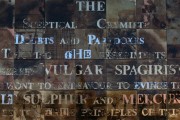This newly acquired work by the Art Gallery of South Australia is a fascinating dreamscape painting with deep symbolism. In this self-portrait we see a return of Platten’s “Miss Havisham” character from a previous work. She stares out at us through a huge monocle and is drawing on a bright white pad of paper. Emanating from the tip of her pencil are thin yellow spidery threads that traverse the lower portion of the canvas. A young girl (the very nice security guard said she thought it might be Platten’s daughter) in a pink dress with a red belt is holding a palette and brush together with a walking stick. She is painting upon a wall; her youthful rosy face contrasts strongly with the face of Platten which is white and withdrawn. It is not the only contrast in this work. On Platten’s side of the canvas are bare sticks and twigs, remnants of plants long dead; they stretch like withered hands toward her while a black bird perches on a small branch in the shadows. A succulent in the bottom corner provides a remnant of life. Yet on side of the young girl; there are small flowers and greener foliage, her face is lit brightly and she is youthful and radiant.
Behind Anna is a cave which seems to bare a vague resemblance to the profile of a baby’s head while in the foreground a small turtle shuffles along the rocky ground. In the distance an organ sun peers over a turbulent sea. This is a highly detailed work, painted with oil on canvas. The composition is such that the eye is directed to the paper; and from this focal point we navigate the rest of the work. What Platten does brilliantly is describe the element of tone. Each object is perfectly rendered in the space; separated though they are, they all share the same light.
Anna Platten has merged a variety of artworks and themes together in this symbolic painting. One such work is Anna Dorothea Therbusch’s Self-portrait, 1777. It tells the story of a short-sighted, middle-aged woman who was hailed as a “wunderkind” in her early years; but gave up painting until later in life, finally returning to it once her spousal obligations had been fulfilled. Platten also utilised the compositional components of a work in the Art Gallery of SA collection; Woman Holding a Book, 1853 by William Strutt.
Originally intending to paint a rather morbid self-reflective piece where the cave was starting to represent a tomb; halfway through it she received a phone call from her sister, saying that her waters had broke and her child was on the way. Rushing to her side she was able to see the safe arrival of baby Zoe, her name meaning life. Afterwards,this work for Platen took on an entirely new meaning; the tomb became a womb, a dark portal from which we all enter this world. The paper and pencil create a web of connections to the surrounding world. The turtle represents a long and steadfast life.
The red belt on the young woman’s pink dress is representative of love as she in turn paints the cave; creating a cycle of life. Ourselves as Zoe is really a celebration of life.

Flower-dedicated to Mark Conway Walter, 2012. It is a large striking portrait of a woman created by Platten after reading Patricia Cornwell’s novel, “Portrait of a Killer: Jack the Ripper—Case Closed”. In this book, Cornwell claims that the 19th century serial killer was actually a painter by the name of Walter Sickert. Anna Platten became fascinated by the humble lives of the women of the streets depicted in the novel. These women had to be self-sufficient to survive. Their skirts; jackets, shirts, coats in fact all their possessions were often sewn into their dresses. The sheer weight of these objects would have been a constant reminder of a sad existence. This figure is one of the ripper’s victims.
This painting; rather than depicting a horrible act, is really showing a kind of transcendence, like a flower, the figure grows out and away from her mortal coil and into another realm. In the centre of her chest is a deep red rose, a symbol of blood love and death. A sky blue ribbon dances around her and provides a sense of depth and also ethereal air. The dress and the character shown in this work are the same as in the Journey Series by Platten. In fact this particular piece could be viewed as the first in the series; where the woman ascends from this world; keeping her soul and dignity intact, to begin a journey of a different kind.



